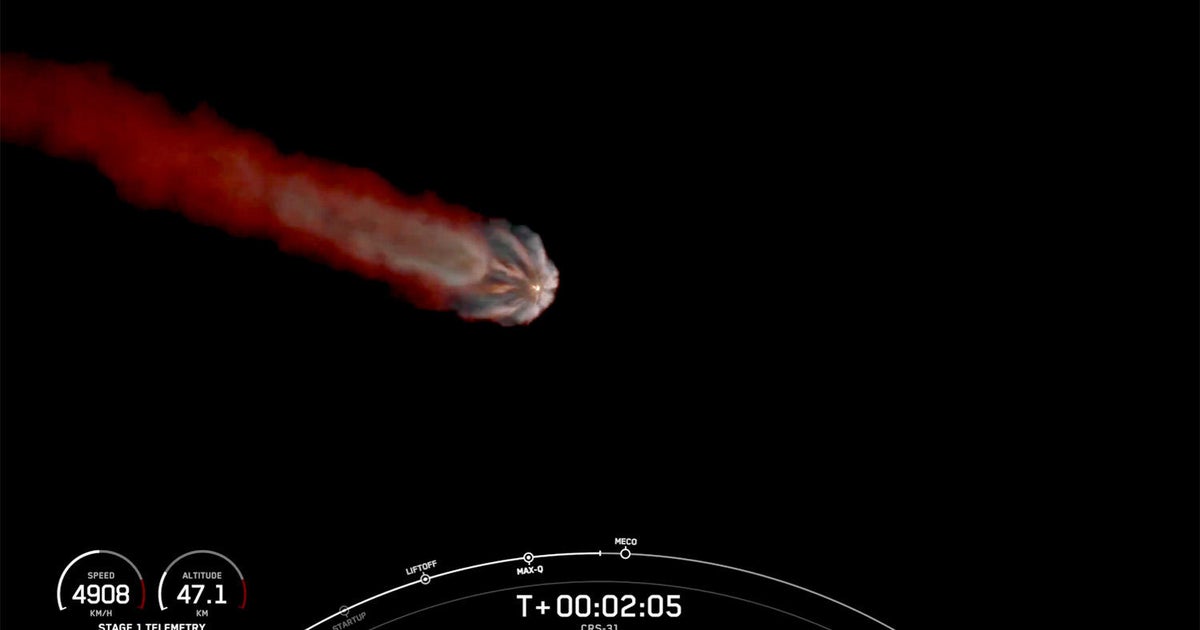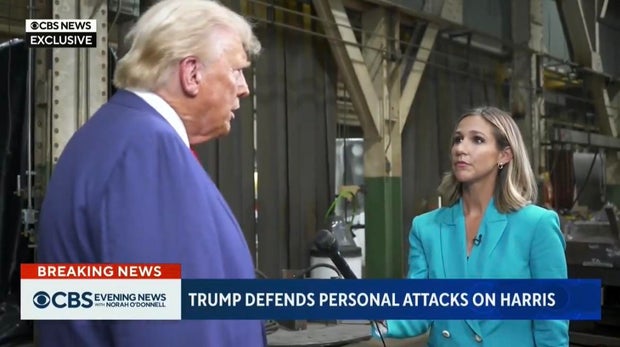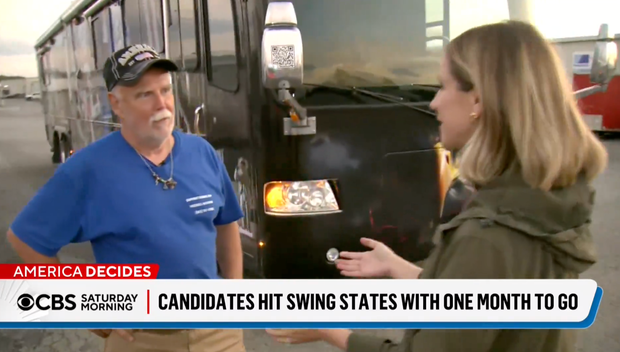CBS News
Notes from a mom of two on the campaign trail: How motherhood has changed the way I think about elections

One afternoon in late August, I was getting ready to interview the former leader of the free world, one of the most famous people on the planet, and my mind was on my toddler, who would be starting pre-school in a few days.
My son was about to go through a major life adjustment, and I was gone. I would be there for his first day, I reminded myself, and this interview would be a career highlight. But I would miss his orientation, meeting his teacher, and other festivities surrounding this rite of passage for my first born.
As I stood in a manufacturing facility in York, Pennsylvania, that afternoon, waiting for former President Donald Trump to talk to me, the pangs of mom guilt felt particularly sharp.
I’ve covered four presidential campaigns, but this one is my first as a mom. This election of a lifetime comes at a precious time in my sons’ lives. I’ve not wanted to miss out on an assignment, and I’ve not wanted to miss out on my kids, ages three and one. I marvel that I get to witness history for a living. And yet I am absent for important moments at home.
But motherhood has changed the way I think about politics and elections for the better. Our process of selecting a leader also serves as a pulse check of the country, and I see a big part of my job as reporting on what Americans say they need and care about. People clearly have a lot of concerns crowding their daily lives: things are expensive, the world seems on edge, and the future feels uncertain. They want a better, safer life for their children — that’s the essence of the American dream. There are just so many different views about what that looks like.
You don’t have to be a mom to understand these things; you just have to be a human. But this time around, I find I have more empathy than I once did. I also worry more than I used to. And some of the biggest issues in this particular election are ones I’m facing myself.
My first question to Trump that day in August was about the child tax credit. I spend half of my take-home salary on child care. As someone who buys gallons of milk a week for my sons, I cringe at the grocery bill. I am concerned about what my child might be exposed to at school, and whether he is physically safe in the building. I went through fertility treatments to have my first son. I know what it’s like to desperately want a child. And I’m lucky enough to know the joy of becoming a parent. I also suffered from postpartum depression. I know how difficult it is to navigate a medical and mental health system that tends to leave mothers behind.
And I understand that I come from a position of immense privilege, with a doting husband who takes on equal, if not more, parenting duties, two incomes, family close by to help, fantastic childcare and a job that I happen to love. The resources I have are not available to most. That is an injustice. And it’s setting women back.
All of this informs my reporting. Many of the voters I’ve met on the campaign trail just need someone to hear them. And I’ve been trying to listen. I’m in awe of people willing to pour their hearts out to a reporter — a complete stranger — in the hopes of making a difference. I won’t forget sitting in a living room in North Carolina as a couple described their difficult IVF journey to me. And I won’t forget a woman I met at a Trump rally in Virginia who told me her son had died from an overdose.
To have conversations like those, I’ve missed some conversations at my own dinner table. I was in a battleground state instead of attending back to school at night. Lately, I’ve spent more nights in hotel rooms than in my kids’ rooms, tucking them into bed.
But my boys are on my mind at every minute, from the big interviews to the small scenes. I got to FaceTime them from the floor of the Republican National Convention. I ordered their Halloween costumes while on the Trump press plane, flying somewhere over the Midwest. I bring them home books from the states I’ve visited so they can learn about where I’ve been. And everytime I see a construction vehicle on the trail, I take photos for my digger-loving three-year-old. (Yes, “the garbage truck” was a hit.)
My youngest son is on the verge of taking his first steps. I’m crossing my fingers that he waits until after I get home from covering the election. But if not, I know he’ll keep walking. And I will, too. Being a mom and being a journalist are the honors of my life. And I am incredibly grateful for this journey.
CBS News
11/4: The Daily Report – CBS News

Watch CBS News
Be the first to know
Get browser notifications for breaking news, live events, and exclusive reporting.
CBS News
11/4: America Decides – CBS News

Watch CBS News
Be the first to know
Get browser notifications for breaking news, live events, and exclusive reporting.
CBS News
Cargo ship launched to space station with supplies, science gear and holiday treats for crew

SpaceX launched an unpiloted Dragon cargo ship Monday evening, an election eve flight to deliver three tons of crew supplies, science gear and other equipment to the International Space Station, including an unusual wooden satellite, a solar wind monitor and holiday fare for the lab’s crew.
The Dragon’s Falcon 9 rocket blasted off from historic launch pad 39A at the Kennedy Space Center at 9:29 p.m. EST, lighting up the night sky for miles around as it climbed away atop 1.7 million pounds of thrust.
NASA/SpaceX
After boosting the rocket out of the dense lower atmosphere, the first stage, making its fifth flight, peeled away, reversed course and headed back to an on-target landing at the Cape Canaveral Space Force Station while the second stage continued the climb to space.
The landing marked SpaceX’s 57th successful booster recovery at the Florida Space Force station and its 363rd overall, including California flights and droneship landings.
Spaceflight Now
Just under 10 minutes after liftoff, the vacuum-optimized engine powering the Falcon 9’s second stage shut down and one minute later, the Dragon was released to fly on its own. If all goes well, it will catch up with the space station Tuesday morning and move in for docking at the lab’s forward port at 10:15 a.m.
One of the first items on the agenda is a test Friday to determine the Cargo Dragon’s ability to boost the space station’s orbit slightly using its aft-facing thrusters. The ISS is routinely re-boosted by Russian Progress freighters and Northrop Grumman Cygnus cargo ships, but Friday’s test will be a first for SpaceX.
The California rocket builder is under contract to NASA to build a powerful space tug of sorts that can be used to safely drive the ISS back into the atmosphere when the lab complex is retired in the 2030 timeframe. The vehicle is needed to make sure the station breaks up over a stretch of ocean well away from populated areas and shipping lanes.
During the test Friday, the Cargo Dragon’s aft thrusters will fire for about 12 minutes.
“The data that we’re going to collect from this reboost and attitude control demonstration will be very helpful, informing SpaceX analyses on how the system performs,” said Jared Metter, SpaceX director of flight reliability. “This data is going to lead to future capabilities, namely the US de-orbit vehicle.”
Reboost aside, the Cargo Dragon is loaded with slightly more than 6,000 pounds of equipment and supplies, including 2,022 pounds of science gear, 2,119 pounds of crew clothing, food and other supplies, 377 pounds of spacewalk equipment, 525 pounds of space station hardware and 44 pounds of computer equipment.
One of the more unusual payloads: Lignosat, a small wooden satellite using a framework of magnolia panels built by researchers at Kyoto University in Japan and the Tokyo-based logging company Sumitomo.
STR/JIJI PRESS / AFP via Getty Images
“While some of you might think that wood in space seems a little counterintuitive, researchers hope that this investigation demonstrates that a wooden satellite can be more sustainable and less polluting for the environment than conventional satellites,” said Meghan Everett, the ISS deputy project scientist.
“The main objective here is to determine whether wood can be used in space, and to do this, researchers will measure the temperature and strain of the wooden structure and see how it might change in the vacuum environment of space with atomic oxygen and radiation conditions as well.”
As with all station-bound Dragon cargo ships, the crew supplies include fresh food and special treats for holiday meals.
Bill Spetch, ISS operations and integration manager, said the “food kit” includes “citrus, apples, sweet onions, blueberries, radishes, etc,” along with lobster, crab and quail for holiday meals. A variety of cheeses is on board as well as fresh coffee and personal items requested by each crew member.
Mounted in the Dragon’s unpressurized trunk section is the Coronal Diagnostic Experiment, or CODEX, an instrument that will be mounted outside the space station to learn more about how charged particles in the solar wind are heated to millions of degrees and accelerated to enormous velocities, affecting Earth’s space environment and the rest of the solar system.
Inside the station, the astronauts will have a variety of new experiments and instruments to operate and monitor, including one called ARTEMOSS that will examine how Antarctic moss tolerates the space radiation and microgravity environment to learn more about how plants might be used in future life support systems.
The European Space Agency is sending up a space exposure experiment to learn more about how high-tech materials respond to prolonged exposure to the weightless environment and another experiment to study how organic samples degrade when exposed to unfiltered ultraviolet light from the sun.
And in an experiment that could be particularly useful to future astronauts, a small device known as Nanolab Astrobeat, provided by the Malta College of Arts, Science and Technology, will test cold welding technology that could prove useful for repairing leaks or other damage from inside a spacecraft.
The Cargo Dragon is expected to remain docked at the space station for about a month before it returns to Earth with station components needing refurbishment, trash and other no-longer-needed items.
















